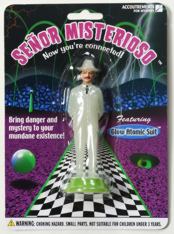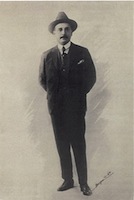José Gregorio Hernández, a pious Venezuelan physician, often provided the poor with medical treatment free of charge. After his death, miracles were attributed to him and 60 or so years after his death the Vatican conferred the title of Venerable upon him. He may someday be declared a saint. While not well known outside Venezuela, he’s widely honored there, a saint in all but title.
A Venezuelan icon artist created idealized statuettes of Dr. Hernández, in an all-white suit (though based on a photo of the doctor in a dark suit). Mark Pahlow, owner of Archie McPhee and long-time aficionado of odd objects, often finds unusual items overstocked outside the United States and sells them repackaged here. He bought a ton of these statues. According to Pahlow, “Since he was mostly unknown to people outside Venezuela, we reinvented him as a mysterious looming figure with a conspiratorial past and a glow in the dark suit” (Who Would Buy This? P. 38). And so Señor Misterioso was born.
Putting aside the ethical questions of whether or not a candidate for sainthood should be rebranded as a glowing international enigma, I find the story fascinating. The same figure can bring about religious reverence or a feeling of kooky espionage. In either case, he’s intriguing. Looking at the dark suited photo, there’s nothing much mysterious about him. He seems a pleasant man in a nice outfit. Reverse the color and reduce the details of his features but add a slight smile and viola, he’s just otherworldly enough to feel quasi-human. And of course, make him glow and you’ve got a man who has been to strange places.
When we speak of an image being iconic, we mean it with a sense of absolute value, of symbolic permanence. But is there any such thing? Pahlow’s change of the doctor’s back-story was completely deliberate, but how often has this sort of transformation occurred gradually and unintentionally? How often have iconic figures dramatically changed meaning?
Another example. Once upon a time there was a goofy, fat and eccentric Chinese monk of Chan Buddhism. His image became a popular sign of good fortune. He is not Shakyamuni Buddha (AKA Siddhartha Gautama). He’s about 1500 years later. And yet, plenty of people immediately think of a fat, smiling statue when they hear the word “Buddha.” I, as both a somewhat chubby person and a Buddhist, have endured a lifetime of jackasses making wisecracks about rubbing my belly. (Perhaps this is why Shaolin monks got into martial arts.)
When I think of the Buddha, I usually picture a hybrid of Mahatma Gandhi (not a Buddhist) the Gandhara Era statues, which are themselves a hybrid of Greek and Indian styles. So my own image can hardly be all that authentic. Siddhartha Gautama, beyond the manifold ways he’s portrayed within Buddhism, inspired, outside of Buddhism, both Herman Hesse’s character and the Catholic Saint Josaphat. If Doctor Hernández is declared a saint, what will become of Señor Misterioso? Perhaps the person of José Gregorio Hernández will have created two entirely separate icons, the saint and the strange glowing figure.
 What is the process of change in iconography? How does something become sacred or profane, and something else go from sacred to comical?
What is the process of change in iconography? How does something become sacred or profane, and something else go from sacred to comical?
This makes me think of Batman. He has been portrayed as everything from mentally ill vigilante to campy enemy of Liberace and all points between. Somehow, American culture has a need to embody these disparate elements in one figure. I think of the absurd nipple-suit version of Joel Schumacher’s Batman and Robin, compared to Alex Ross’s black and white portrait of a lacerated veteran. A hundred years from now, which image of Batman will be the most iconic?
The recent revisions and retellings of Batman, Doctor Who, Battlestar Galactica and so forth show a conscious desire to modify the iconic. The Cold War ended and we still wanted James Bond, but it couldn’t be the same James Bond as before. We wanted a harder, bloodier and less pretty Bond, and it worked well.
Icons can change gradually, as well, reflecting how a culture sees itself. Cowboys, in the 1940s and 50s radio and film, were the clean-cut and daring knights of the prairie and fit the way Americans saw their global presence, especially in World War Two. In the beginning of the 1960s, not long after the Vietnam War began, the shift away from the clean-cut cowboy hero came with The Magnificent Seven. Samurai became ronin, you could say. The end of the 1960s, with a long-standing and controversial war on every American’s mind, gave us The Wild Bunch. Hopalong Cassidy had given way to Butch Cassidy. The days of singing cowboys in white were long gone.
What next? What is the significance of a show like LOST, which has a ton of characters but deliberately muddles archetypes? In urban fantasy, wizards have merged with detectives. The most popular vampires right now sparkle in daylight. Have vampires lost their menace entirely? What icons are changing now?
When Jason Henninger isn’t reading, writing, juggling, cooking or raising evil genii, he works for Living Buddhism magazine in Santa Monica, CA.










